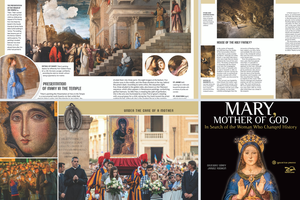Sacred Art for the Solemnity of the Mother of God: The Faces of Jesus and Mary
BOOK EXCERPT

Editor’s Note: The following is an excerpt from Solemnities: Celebrating a Tapestry of Divine Beauty.
Catholics see the world as a marriage of the spiritual and material, not a divorce of these two realties. The very title of Mary as “Mother of God” shows the intrinsic connection between the material and spiritual realms. Let’s consider what this means. First, notice that the Second Person of the Trinity — eternal, infinite, omnipotent — becomes incarnate through a human mother! Second, “Mother of God” means that humanity and divinity, the material and the spiritual, earth and heaven, exist inseparably from the point of the incarnation of Jesus in the womb of Mary, his human mother.
This solemnity has had other names in the Church’s history, all of which likewise emphasize the earthiness of this fundamental tenet of the faith. The Roman Missal still refers to this day as “The Octave Day of the Nativity of the Lord.” Aside from Easter, Christmas is the foremost mystery of our faith. Since the celebration of the Resurrection on Easter cannot be contained within a twenty-four-hour period (which is why we celebrate it for eight days during the Octave of Easter, as well as every Sunday), the celebration of Christmas lasts eight days. The meaning of this solemnity, then, is the same as that of Christmas: “The Word became flesh, and we have seen his glory.” In Jesus, our faith in God is tangible; it is no longer abstract.
Another of this day’s traditional titles, “The Circumcision of Our Lord,” similarly expresses the human dimension of our faith. The Gospel reading on this day recounts the visit of the shepherds to the Holy Family after the birth of Jesus, the same story that the Church recounts at Christmas Mass at Dawn. But today, the Church concludes the reading with this extra detail: “And at the end of eight days, when he was circumcised, he was called Jesus, the name given by the angel before he was conceived in the womb” (Luke 2:21). From the time of Abraham, every male child was circumcised on the eighth day as a sign of being a part of the covenant with God (see Genesis 17:9-14). The Lord now has a mother, a body, a human name, and — as signaled by his circumcision — physical pain. This first day of the civic calendar announces through the circumcision of Jesus that he is among us, one of us, suffering with us, and beginning the year with us.
Still another connection between our eternal, supernatural religion and our temporal, mundane life is that this solemnity coincides with the first day of the secular year. This first day of the year had been celebrated in Rome prior to Christ’s coming. Janus, the two-faced Roman god of beginnings and endings, is where the name “January” for the first month of the year is derived. With the coming of Jesus — the Alpha and Omega, the beginning and the end of all time — Janus finds his true bearings. Though the texts and prayers of this day’s liturgies do not acknowledge the start of the civil year (the Church, after all, has already begun its new liturgical year with the start of Advent some weeks before), marking its first day helps the Church on earth to thank God for blessings received over the past year and ask for his ongoing care in the year ahead.
But none of these human dimensions of our faith that this day expresses — its connection to Christmas, to Jesus’ human body, to his entering into time itself — would have been possible without Mary agreeing to become the Mother of God. It is thus this dimension of the day that rises to the top.
After all, the very face of Jesus comes from his mother Mary. Indeed, he would have physically resembled her to some extent — he may have had her eyes, her expressions, her smile. Through this face, God now speaks: “In the past God spoke to our ancestors through the prophets; in these last days, he has spoken to us through the Son” (verse for the Gospel acclamation). We read in the Old Testament about how God’s people, when they heard the thunderous voice of the Lord, were afraid and sent Moses to hear God in their stead (see Exodus 20:18-19; and Deuteronomy 5:22-28; 18:16–18). At the Incarnation, the same God speaks in a different way, a human way, through Jesus’ voice and face, given him by the holy Mother of God, Mary.
And it is with this body — one like yours and mine — that this same voice can praise and adore the Father in our name and can offer his body and soul to him. As St. Athanasius explains in the Office of Readings for this day, the Word “had to be like his brothers in all things. He had then to take a body like ours. This explains the fact of Mary’s presence: She is to provide him with a body of his own, to be offered for our sake. … What was born of Mary was therefore human by nature … and the body of the Lord was a true body: It was a true body because it was the same as ours.”
Jan. 1, the Solemnity of Mary, the Holy Mother of God, proclaims the accessibility of our Catholic faith — it is human, incarnate, tangible — even as it calls us to the higher things — divinity, heaven, and glory — in the new year.
View the related The Sacred Image series here.
- Keywords:
- mary, mother of god
- sacred art
- book picks
















